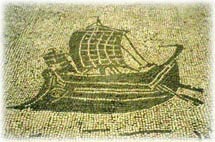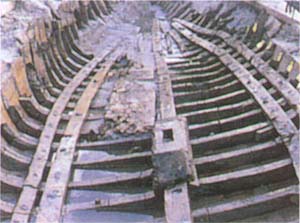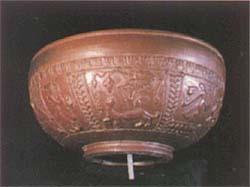Underwater HistoryThroughout history the Mediterranean has been the great nexus of union between the nations that made up its shores. For it was the principal means of communication between peoples and cultures, a natural highway which allowed for the exchange of ideas and products. At the same time the rivers, lakes and marshlands served as routes for penetrating into the hinterlands and their banks became the ideal sites for human settlement.
A merchant ship is testimony to a trading operation between two geographically distinct zones: it reflects the economic, social, technological and cultural situation of the port of origin and the port of destination, at which it never arrived. It is an archaeological site, a historical document which speaks to us about the societies of the men who made it possible that such a ship should set off on such a voyage. However, it is necessary to possess sufficient knowledge and experience, in order to correctly interpret the information which has thus become available to us. The waters off Catalonia which, almost 2,500 years ago, allowed Greek navigators from the other side of the Mediterranean, and, centuries later, the disembarkation of the Roman armies, culminating in the Romanization of the Iberian Peninsula, and still later, in the Middle Ages, the expansion of Catalan influence as far as Greece itself, these waters are fully representative of the problems of Mediterranean navigation, and beneath the surface lie innumerable testaments to this cultural past.
Over recent decades technical and methodological advances have allowed access to subaquatic archaeological remains, an their exploitation as a source of historical information. However, at the same time, the extension of human pressure along the coasts, and on the bottom of the sea, has accelerated the process of destruction of this enormously fragile heritage. In order to counteract this problem, in 1992, the Generalitat (Autonomous Government) of Catalonia, created the Subaquatic Archaeological Centre of Catalonia, the CASC (Centre d'Arqueologia Subaquàtica de Catalunya) charging it with the following missions: the inventory, protection, conservation, study and spreading of the archaeological heritage of Catalonia which is found submerged under coastal and inland waters. The CASC has formed a part of the Archaeological Museum of Catalonia (Museu d'Arqueologia de Catalunya) since 1996. A highly diversified cultural heritage
It was possible to transport practically everything by naval means: men, bulk foods, or foods contained in amphoras, building materials, metal ingots, all kinds of trade objects, including those for use in warfare. Cargoes which, together with the personal possessions of the travellers and the crew, can be found on the sea bed. At the same time, the remains of constructions, such as the port structures of Empúries, or of the Neolithic settlement of La Draga, partly submerged in the lake at Banyoles, which, with an antiquity of 7,000 years, is the oldest subaquatic site in Catalonia, and includes pavements made of the bark from trees, which have been discovered, along with flint tools, still attached to their wooden handles.
The specific conditions provided by water allows for conversion of organic materials, such as cloth, leather, wood, food remains, etc., elements which, in contact with the air would have disappeared long ago. Also thanks to this conservation capacity we have been able to discover what Roman wooden ships were really like, such as the one at Cap de Volt (Port de la Selva), or Mediaeval ships, such as the Culip VI, off Cadaqués, or Les Sorres X (Castelldefels) from the 14th century. From this basis we can make great advances in our understanding of historical naval technology and sailing conditions. The Centre d'Arqueologia Subaquàtica de Catalunya (CASC)The creation of the CASC allowed for the extension, throughout the whole of Catalonia, of the actions which, since 1981, had been undertaken in the counties of Girona by the Subaquatic Archaeological Department of the Girona Archaeological Technical Service. This department was, at the same time, involved in the continuation of the work of the Submarine Excavations Council of the provincia marítima de Gerona, which was created by ministerial order in 1972.
The operations of the CASC include the development of its own projects, as well as the provision of technical support for other, external, archaeological teams, to which end it has a range of machinery and instruments, particularly the 22 metre boat "Thetis" (with a capacity for a crew of 12), which works as a back up to subaquatic archaeological work. As a centre of investigation, and the undertaking of the practical training of new archaeologists, the CASC keeps up an inventory of the subaquatic heritage of Catalonia, and in Girona has its headquarters, warehouses, a specialised library and laboratories for the restoration and conservation of humid archaeological materials, particularly those of organic origins. Since its creation the CASC has invested a great deal of time in the drawing up of a subaquatic archaeological map of Catalonia: the inventory of sites, their characteristics and state of conservation. This is considered as a vital first stage for the effective programming of future projects. Common heritage
Subaquatic archaeological sites are our common heritage, and their conservation also depends on us. The hobby of collecting relics, the desire to possess a trophy as a reminder of a subaquatic expedition, the exploitation of natural resources, the building of public works projects, and the illegal trade in antiquities have irreparably damaged, and continue to damage, our subaquatic cultural heritage. In order to guarantee public enjoyment, and the passing on of this inheritance to future generations, certain measures of legal protection have been drawn up. "... those assets, both tangible and intangible, of a historical character, which are susceptible to study using archaeological methodology, whether or not they have been extracted, or have been found on the surface or underground, within the territorial bounds of the sea or on the continental shelf, all form a part of Spanish Historical Heritage ..." (Article 40 of the Spanish Historical Heritage Bill of 16/1985, of 25th June). "... Information concerning the discovery of remains with an archaeological value, found by chance ( ... ) will have to be communicated, within a period of forty-eight hours, to the Department of Culture of the corresponding town or city council ( ... ) when it is a case of a subaquatic find then the object must be left in its original location ..." Article 51 of the Catalan Cultural Heritage Bill (9/1993, of 30th September). Centre d'Arqueologia Subaquàtica de Catalunya Pedret, 95 17007 Girona Catalonia, Spain Tel. +34-972 20 66 31 Fax +34-972 2104 54 Tel. Ship Thetis +34-908 19 56 55 email casc@mac.es Related link |
 This
continuous use of the waters has meant the leaving behind of innumerable mementoes of human
activity, in the form of sunken ships, port constructions, the inventiveness employed in harnessing
its natural resources, or simply lost and abandoned objects. Man has always attempted to recover
objects which have fallen to the sea bed, to recover something considered to be of value. In order
to achieve this end he has, over the ages, invented and perfected machines, apparatus, and
techniques which have made the work both easier and safer. An antique object, however, is much more
than something with a merely economic value.
This
continuous use of the waters has meant the leaving behind of innumerable mementoes of human
activity, in the form of sunken ships, port constructions, the inventiveness employed in harnessing
its natural resources, or simply lost and abandoned objects. Man has always attempted to recover
objects which have fallen to the sea bed, to recover something considered to be of value. In order
to achieve this end he has, over the ages, invented and perfected machines, apparatus, and
techniques which have made the work both easier and safer. An antique object, however, is much more
than something with a merely economic value.




 Back to Nordic Underwater Archaeology
Back to Nordic Underwater Archaeology